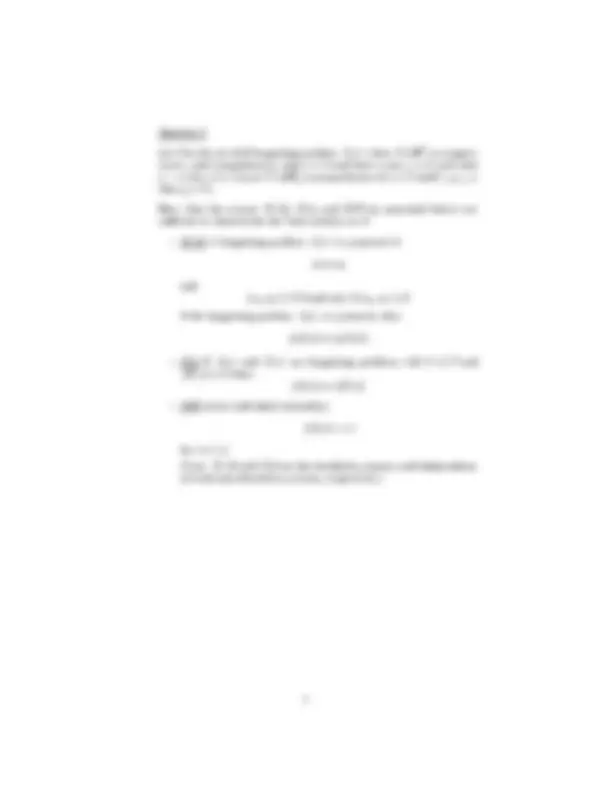



Study with the several resources on Docsity

Earn points by helping other students or get them with a premium plan


Prepare for your exams
Study with the several resources on Docsity

Earn points to download
Earn points by helping other students or get them with a premium plan
Community
Ask the community for help and clear up your study doubts
Discover the best universities in your country according to Docsity users
Free resources
Download our free guides on studying techniques, anxiety management strategies, and thesis advice from Docsity tutors
Two theory field exam questions related to game theory. The first question focuses on finding the set of pure-strategy nash equilibria and the symmetric mixed-strategy equilibrium of a one-shot game, as well as the set of pure-strategy sequential equilibria of a dynamic game. The second question deals with showing that the axioms of symmetricity, independence of irrelevant alternatives, and strict individual rationality are sufficient to characterize the nash solution for a specific set of bargaining problems.
Typology: Exams
1 / 3

This page cannot be seen from the preview
Don't miss anything!


August
Consider the following situation. A buyer and seller are interested in possibly engaging in trade. The buyer has utility vqχ − t, where v is his marginal value of quality, q; χ = 1 indicates he has obtained the good, χ = 0 indicates he has not; finally, t is a transfer from buyer to seller. The seller has utility t − χcq^2 , where c is a parameter related to the seller’s marginal cost of producing quality. Assume that v and c are independently distributed uniformly on [0, 1]. Let each party have a reservation utility of zero. Assume the timing is as follows, the parties learn their types, then meet to engage in possible trade. When trade occurs, the parties can specify the quality of the good, q. Assume quality is verifiable.
(a) As a function of c and v, what is the first-best level of q and χ?
Assume that each party’s type is that party’s private information. Assume each party has a reservation utility of 0.
(b) Suppose the buyer can make a take-it-or-leave-it offer of a contract (mech- anism) to the seller. What mechanism does he offer in equilibrium?
(c) Suppose the seller can make a take-it-or-leave-it offer of a contract (mech- anism) to the buyer. What mechanism does she offer in equilibrium?
(d) Does either mechanism maximize welfare?
Change the assumptions as follows: Assume there are two states of nature, H (for high variance) and L (for low variance). Assume the probability the state is L is α, α ≥ 1 /2. In state H, the model is as described above. In state L, the buyer’s v ∼ U [1/ 2 , 1] and the seller’s c ∼ U [0, 1 /2]. Assume the parties don’t observe which state occurs, but do know their own types. Assume, henceforth, that the buyer makes a take-it-or-leave-it offer.
(e) What mechanism would a buyer offer in equilibrium if his v < 1 /2?
(f) What mechanism would a buyer offer in equilibrium if his v ≥ 1 /2?
Theory Field Examination Game Theory (209A) Aug 2009
Both questions carry the same weight. Good luck!!!
Question 1
A monotone game is an extensive game with perfect information and simultaneous moves in which players are constrained to choose stage- game strategies that are non-decreasing over time. Consider the following monotone game which is naturally interpreted as a voluntary contribution game:
— There are three players indexed by i = A, B, C, and T periods in- dexed by t = 1, ..., T. Each player has an endowment of one indivisi- ble token that he can contribute to the production of a public good. The contribution can be made in any of the three periods, but the decision is irreversible: once a player has committed his token, he cannot take it back. — Let xit denote the amount contributed by player i at the end of period t. Then we can represent the state of the game in period t by a vector
xt = (xAt, xBt, xCt) ∈ { 0 , 1 } × { 0 , 1 } × { 0 , 1 }.
The fact that the players’ decisions are irreversible implies that xit+1 ≥ xit for each player i; or, in vector notation, xt+1 ≥ xt. The initial state of the game is defined to be x 0 = (0, 0 , 0). — The players’ payoffs are functions of the final state of the game xT = (xAT , xBT , xCT ). The public good is indivisible and costs two tokens to produce. The good is provided if and only if the total contribution is at least two tokens. If the public good is provided, each player receives a payoff equal to two tokens plus his initial endowment of one token minus his contribution. If the public good is not provided, each player receives a payoff equal to his initial endowment minus his contribution. [I] Find the set of pure-strategy Nash Equilibria and the symmetric the symmetric mixed-strategy equilibrium of the one-shot game (T = 1). Find the set of pure-strategy sequential equilibria of the dynamic games (T ≥ 2 ). [III] Consider the strategy profile where one player contributes at the first period anticipates and his opponents play the symmetric mixed-strategy equilibrium at the second period. Is this a se- quential equilibrium in the two-period game (T = 2)?